Papers by Athanasios Vionis
Journal of Greek Archaeology, 2023
This paper presents the activities carried out in the context of the public outreach framework of... more This paper presents the activities carried out in the context of the public outreach framework of the Settled and Sacred Landscapes of Cyprus (SeSaLaC) and the Unlocking the Sacred Landscapes of Cyprus (UnSaLa-CY) projects of the Archaeological Research Unit of the University of Cyprus in a former conflict zone, the Xeros River valley (Larnaca district) in Cyprus. The public outreach initiatives were born out of the long-term aim of the projects to encourage public engagement and interaction of the present-day communities in the Xeros valley with the cultural heritage of the region.

Cyprus in the Long Late Antiquity: History and Archaeology between the Sixth and Eighth Centuries, 2022
The aim of this paper is to examine and understand the passage from the ‘late antique’ to the ‘By... more The aim of this paper is to examine and understand the passage from the ‘late antique’ to the ‘Byzantine’ world of the early Middle Ages, alongside issues of continuity and break in settlement formation, population growth, and rural economy in Cyprus, through a landscape approach. By examining the survey dataset of the archaeological project ‘Settled and Sacred Landscapes of Cyprus’ (SeSaLaC), an attempt is made to gauge the meaning of surface ceramic scatters in the Xeros River valley (Larnaca district) on the southern coast of Cyprus. The appreciation of this dataset within the wider context of the island – in particular the relationship to larger settlement catchments, the emergence of ‘secondary local centres’, and mechanisms of resilience within a new social, religious, and economic setting – can provide a valuable reconstruction of landscape history. Contemporary approaches to an archaeology of islands or concepts of insularity, an informed understanding of seasonality, and a modified version of internal colonisation constitute the main paths followed in order to grasp settlement transformation in Cyprus throughout Late Antiquity and the Byzantine early Middle Ages, especially from the late sixth to the mid-tenth century.
24th International Congress of Byzantine Studies: Proceedings of the Plenary Sessions, 2022
This contribution aims at investigating the application of theoretical and digital approaches to ... more This contribution aims at investigating the application of theoretical and digital approaches to the ‘sacred’. Apart from highlighting the potential of spatial analyses and other computational approaches in Byzantine Archaeology, this paper explores issues of reception and appropriation of the Byzantine past in our contemporary world through the employment of state-of-the-art digital tools, Neurosciences and the practice of Community Archaeology. The constructive application of digital technologies and the smart incorporation of archaeological and anthropological theory expands into innovative directions in the field of Byzantine Studies.
Religions 13, 903, 2022
The introductory article offers a general overview of the highly complicated concept of insularit... more The introductory article offers a general overview of the highly complicated concept of insularity as discussed variously in historical and archaeological discourse. It also provides a context of sacred landscapes and religious identities, when discussed in relation to insularity. Finally, it outlines the general themes discussed in this Special Issue and situates the Unlocking Sacred Landscapes (UnSaLa) research network and the current volume in the context of the current state-of-art.
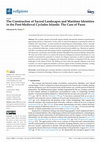
Religions 13, 164, 2022
The Cyclades islands in the South Aegean initially attracted the attention of prehistorians appro... more The Cyclades islands in the South Aegean initially attracted the attention of prehistorians approaching islands as ‘laboratories’ for the study of cultural development, examining the notions of ‘isolation’ and ‘connectivity’, or, more recently, by introducing new terminologies, such as ‘seascape’ and ‘islandscape’. The wealth of material remains of the post-medieval era in the Cyclades islands (e.g., ecclesiastical architecture, ceramics) and the textual record available (e.g., Ottoman tax registers, travellers’ accounts) provide fascinating evidence regarding the construction of sacred landscapes, self-expression, community, and maritime identities throughout the period of Ottoman domination. The main aim of this article is to examine the historical contingencies and the distribution of a vast number of rural churches, primarily as evidence for religious expression, in order to capture island dynamics and the formation of religious and community identities, as imprinted onto the sa...

Land 10, 1365, 2021
Mapping surface ceramics through systematic pedestrian archaeological survey is considered a cons... more Mapping surface ceramics through systematic pedestrian archaeological survey is considered a consistent method to recover the cultural biography of sites within a micro-region. Archaeologists nowadays conduct surface survey equipped with navigation devices counting, documenting, and collecting surface archaeological potsherds within a set of plotted grids. Recent advancements in unmanned aerial vehicles (UAVs) and image processing analysis can be utilised to support such surface archaeological investigations. In this study, we have implemented two different artificial intelligence image processing methods over two areas of interest near the present-day village of Kophinou in Cyprus, in the Xeros River valley. We have applied a random forest classifier through the Google Earth Engine big data cloud platform and a Single Shot Detector neural network in the ArcGIS Pro environment. For the first case study, the detection was based on red–green–blue (RGB) high-resolution orthophotos. In contrast, a multispectral camera covering both the visible and the near-infrared parts of the spectrum was used in the second area of investigation. The overall results indicate that such an approach can be used in the future as part of ongoing archaeological pedestrian surveys to detect scattered potsherds in areas of archaeological interest, even if pottery shares a very high spectral similarity with the surface.

Ioannides M., Fink E., Cantoni L., Champion E. (eds) Digital Heritage. Progress in Cultural Heritage: Documentation, Preservation, and Protection. EuroMed 2020. Lecture Notes in Computer Science, vol 12642. Springer, Cham, 2021
Landscape studies have evolved into a significant branch of historical archaeological research, b... more Landscape studies have evolved into a significant branch of historical archaeological research, by placing emphasis on the ecological, economic, political and cultural values of pre-modern settled and sacred landscapes. The aim of our work is to support the systematic exploration of landscape archaeology in the Xeros River valley in Cyprus, through time, from prehistory to today, through the design and development of an Augmented Reality (AR) application. The AR application supports the exploration of pre-modern monuments and archaeological sites in the Xeros River valley, serving as a guided tour for visitors of the area. By employing image recognition and utilizing a location-based practice, the application provides the users with an immersive and educational experience. Initial reactions by experts in landscape studies indicate the potential of the application in enabling the narration and visualization of the historicity of the landscape and the fate of religious and other monuments of the past 1500 years.
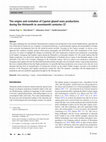
Archaeological and Anthropological Sciences, 2021
This paper challenges the conventional characterisation of glazed ware productions in the eastern... more This paper challenges the conventional characterisation of glazed ware productions in the eastern Mediterranean, especially the ones which did not feature the use of opaque or tin-glazed technology, as technologically stagnant and unsusceptible to broader socioeconomic developments from the late medieval period onwards. Focusing on the Cypriot example, we devise a new approach that combines scientific analyses (thin-section petrography and SEM-EDS) and a full consideration of the chaîne opératoire in context to highlight the changes in technology and craft organisation of glazed ware productions concentrating in the Paphos, Famagusta and Lapithos region during the thirteenth to seventeenth centuries CE. Our results indicate that the Paphos production was short-lived, lasting from the establishment of Frankish rule in Cyprus in the thirteenth century to the aftermath of the fall of the Crusader campaigns in the fourteenth century. However, glazed ware production continued in Famagusta and Lapithos from the late thirteenth/fourteenth centuries through to the seventeenth century, using technical practices that were evidently different from the Paphos production. It is possible that these productions were set up to serve the new, local demands deriving from an intensification of commercial activities on the island. Further changes occurred to the technical practices of the Famagusta and Lapithos productions around the 16th/17th centuries, coinciding with the displacement of populations and socio-political organisation brought by the Ottoman rule.
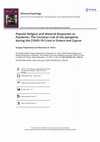
Ethnoarchaeology 12.2, 2020
This article explores the materiality of the Orthodox Christian cult of the Epitaphios on Good Fr... more This article explores the materiality of the Orthodox Christian cult of the Epitaphios on Good Friday of 2020 when, during the COVID-19 pandemic, social distancing and isolation were deemed the most effective means of protecting societies from exposure to the virus. Epitaphios is a metonym that references a venerated object, a decorated cloth or wooden icon bearing the image of Christ prepared for burial. It is placed upon a wooden bier, representing the Tomb of Christ, also called the Epitaphios. During the pandemic, people reacted inventively to restrictions imposed on practicing this communal cult publicly in churches by constructing homemade Epitaphioi and displaying them in privately-owned spaces. We examine the materiality of the homemade Epitaphioi in the context of popular religion, evaluating how crisis may divert the forces of the longue durée into a different channel, and how ethnographic analogy may be useful for understanding ritual and cult in archaeology.

HEROM: Journal on Hellenistic and Roman Material Culture, 9, 2020
The aim of the present paper is to explore three main ceramic-related issues, integrated within t... more The aim of the present paper is to explore three main ceramic-related issues, integrated within the economic, political and cultural framework(s) of the period. Although trends in pottery typology and ceramic production in the period between the late 7th and 9th/10th centuries do not reflect the high level of standardisation of the preceding Roman and Late Roman (Late Antique) mass-produced wares of Italy, North Africa, western Asia Minor, Egypt and Cyprus, they do reflect general trends and ‘cultural groupings’ to a certain degree. Thus, the aim here is to examine (a) the diversity of ‘local’ pottery types in this period and their reflection on a ‘regional’ or ‘global’ scale, (b) whether the ceramic corpus suggests that this was an era of transitions, transformations or continuities, and (c) the degree of quality and uniformity of ceramic assemblages dated to the Byzantine Early Middle Ages.
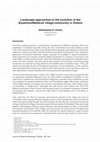
Journal of Greek Archaeology, 5, 2020
This paper brings together archaeological evidence, textual references, and spatial analyses in o... more This paper brings together archaeological evidence, textual references, and spatial analyses in order to reconstruct the formation and evolution of the ‘village’ as socio-economic and power structure throughout the Byzantine/Medieval era (ca. 8th/9th–14th/15th centuries AD). Special reference is made to central Greece (i.e. Boeotia) and a comparison is attempted with small and large islands (e.g. Paros, Naxos, Cyprus) in order to briefly discuss the economic, territorial and spiritual identities of the village-community within a hierarchical settlement system. The contextualization and evaluation of settlement-change and village-formation in post-Antique Greece is carried out for the purposes of this paper along four main strands of geographical, theoretical and landscape-archaeology approach: (a) Siedlungskammer or ‘Settlement Chambers’, (b) ‘Central Place Theory’ and settlement hierarchies, (c) ‘Village Ecosystems’ and land-use patterns, (d) ‘Sacred Landscapes’ and the role of the church.

Journal of Greek Archaeology, 5, 2020
This article deals with a relatively new form of archaeological research in the Mediterranean reg... more This article deals with a relatively new form of archaeological research in the Mediterranean region – intensive surface survey, coverage of the landscape by teams walking in close order, recording patterns of human activity visible on the landsurface as scatters of pottery and lithics, or building remains. Since 2000, archaeologists from Dutch and Belgian universities working on Mediterranean survey projects have gathered annually to discuss methodological issues in workshops that gradually attracted landscape archaeologists from other European countries and Turkey. On the basis of these discussions, this paper, written by regular workshop contributors and other invited authors with wider Mediterranean experience, aims to evaluate the potential of various approaches to the archaeological surface record in the Mediterranean and provide guidelines for standards of good practice in Mediterranean survey.
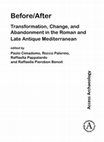
Before/After. Transformation, Change, and Abandonment in the Roman and Late Antique Mediterranean, edited by Paolo Cimadomo, Rocco Palermo, Raffaella Pappalardo and Raffaella Pierobon Benoit, 2020
War, earthquakes and plagues are usually listed amongst the most popular phenomena for explaining... more War, earthquakes and plagues are usually listed amongst the most popular phenomena for explaining the ‘shrinkage’, ‘decline’, ‘abandonment’, ‘transition’ and ‘transformation’ of urbanisation and/or rural life in the Eastern Roman Empire from the late sixth to the seventh and eighth centuries. Several scholars have seen variations in the scale and effects of external threat and natural disasters but these changes have been poorly understood by Byzantinists. A re-evaluation of the archaeological evidence at hand is of emergency before we move on to interpretations and concrete conclusions about early medieval ‘abandonment’ in the Byzantine provinces. I would argue that major transformations did happen throughout the period in question, although the criteria for determining changes, accommodations and transformations in the Early Middle Ages should be viewed in a different, rather more optimistic, angle. As it will become clear through the employment of a different model for reading the impact of abandonment’ in the material record (e.g. settlement shrinkage vs. evolution, industrial decline vs. local production, hybrid forms in art vs. new cultural identities) from the Aegean islands and mainlands, it is suggested that marginal areas became active arenas of constant negotiation and adaptation between the local element and emerging powers of political and economic control.
Archaeological Reports 65, 2019
Some areas of the territory of present-day Greece were under Ottoman rule for more than 500 years... more Some areas of the territory of present-day Greece were under Ottoman rule for more than 500 years. To date, the study of this period has largely been neglected, with academic research generally focused on Prehistoric and ancient Greece. However, over the course of the last 20 years, there have been noteworthy developments in the study of the Ottoman history and archaeology of Greece. This paper has two aims: (1) to summarize research conducted in the fields of Ottoman archaeology and material culture in Greece, focusing on demographics, settlement layouts and ceramics, particularly table wares; and (2) to present recent efforts to record and protect the Ottoman monuments of Greece.
Journal of Archaeological Science: Reports, vol. 28, 2019

Open Archaeology 5.1, 2019
In this editorial article for the Special Issue on "Unlocking Sacred Landscapes: Digital Humaniti... more In this editorial article for the Special Issue on "Unlocking Sacred Landscapes: Digital Humanities and Ritual Space" (Open Archaeology Journal: De Gruyter), we introduce the applicability of digital humanities to the study of ritual space. The Issue focuses on digital approaches both to ritual space and to artefacts relating to ritual practice and cult. The terms ritual and cult are used broadly to include sanctuaries, temples and churches, as well as the domestic and funerary spheres of life. We include contributions with a strong methodological focus on computational developments, digitisation processes and spatial analyses. Although the main focus of the Unlocking Sacred Landscapes (UnSaLa) Research Network is the Mediterranean region, we have also encouraged colleagues working in other areas of the world to contribute to this volume, with a view to stimulating wider methodological dialogues and comparative approaches. The chronological span ranges from prehistory to the recent past, and includes cultural heritage management.
Unlocking Sacred Landscapes: Spatial Analysis of Ritual and Cult in the Mediterranean, edited by G. Papantoniou, Ch. Morris and A.K. Vionis, 2019
Unlocking Sacred Landscapes: Spatial Analysis of Ritual and Cult in the Mediterranean, edited by G. Papantoniou, Ch. Morris and A.K. Vionis, 2019
The publication of this volume has been funded by the Irish Research Council, the A.G. Leventis F... more The publication of this volume has been funded by the Irish Research Council, the A.G. Leventis Foundation and the Research and Innovation Foundation of Cyprus Cover image: A Minoan bronze worshipper figurine and a sacred landscapes skyline. The design represents the idea of Mediterranean sacred landscapes and their artefacts, thus capturing the scope and spirit of the UnSaLa research network (illustrations by J. Doole [figurine] and B. Cheimariou [landscape skyline])
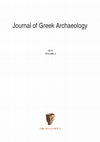
Journal of Greek Archaeology 4, 2019
This paper aims at identifying the materiality of female presence in the burial context along two... more This paper aims at identifying the materiality of female presence in the burial context along two main strands of funerary ritual and cultic behaviour. The first concerns the mourning of the dead and female devotional practice, while the second involves the deposition of personal objects carrying protective and apotropaic properties (usually related to health and fertility), and the creation of secret and mysterious κατάδεσμοι or defixiones (as expressions of sexual desire through binding curses). The ultimate aim is to visualise women in the Late Antique – Early Byzantine period within the often marginalised and overlooked domestic and cultic spheres, in order to appreciate their position in a (largely) Christianised Eastern Roman society between the late 4th and early 8th centuries AD. Material and visual evidence for female presence in funerary ritual and cultic context has been put together and consulted, while textual references and inscriptions related to binding curses and other ‘magic’ related paraphernalia have also been considered in order to read the gendered association of death. Religious iconography of later centuries depicting saintly women in funerary-related areas within churches and the acts of women as mourners, mothers and wives, on the other hand, help immensely in comprehending female manners and extraordinary behavioural patterns in both funerary ritual and cult.
Journal of Archaeological Science: Reports

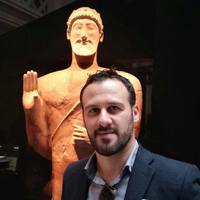



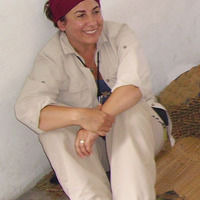





Uploads
Papers by Athanasios Vionis
Main web page: https://place-itn.cyi.ac.cy/